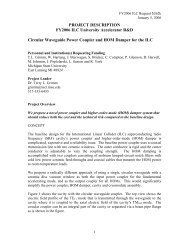order denying motions to suppress and dismiss - University of Illinois ...
order denying motions to suppress and dismiss - University of Illinois ...
order denying motions to suppress and dismiss - University of Illinois ...
- No tags were found...
Create successful ePaper yourself
Turn your PDF publications into a flip-book with our unique Google optimized e-Paper software.
1<br />
2<br />
3<br />
4<br />
5<br />
6<br />
7<br />
8<br />
9<br />
10<br />
11<br />
12<br />
13<br />
14<br />
15<br />
16<br />
17<br />
18<br />
19<br />
20<br />
21<br />
22<br />
23<br />
24<br />
25<br />
26<br />
27<br />
28<br />
UNITED STATES DISTRICT COURT<br />
EASTERN DISTRICT OF WASHINGTON<br />
UNITED STATES OF AMERICA, ) NO. CR-05-180-LRS-1<br />
Plaintiff, CR-05-180-LRS-2<br />
) CR-05-180-LRS-6<br />
CR-05-180-LRS-7<br />
v. ) ORDER DENYING MOTIONS<br />
) TO SUPPRESS AND DISMISS<br />
DIXIE ELLEN RANDOCK, STEVEN KARL RANDOCK, SR., )<br />
HEIDI KAE LORHAN, ROBERTA LYNN MARKISHTUM, ) Defendants. )<br />
______________________________ )<br />
BEFORE THE COURT are the Defendants’ Motion To Suppress<br />
Evidence (Ct. Rec. 328) <strong>and</strong> the Defendants’ Motion To Dismiss Indictment, Or<br />
Alternatively, Suppress Evidence (Ct. Rec. 342).<br />
On Oc<strong>to</strong>ber 15-18 <strong>and</strong> November 13-16, 2007, an evidentiary hearing was<br />
conducted on these <strong>motions</strong> in Spokane. Concluding oral arguments were heard in<br />
Yakima on January 10, 2008. The court has considered the evidence presented<br />
(testimony <strong>and</strong> exhibits) <strong>and</strong> the oral arguments in making these rulings.<br />
I. BACKGROUND<br />
In January 2005, the United States Secret Service initiated an investigation<br />
in<strong>to</strong> a number <strong>of</strong> Internet-based virtual schools that were alleged <strong>to</strong> have<br />
fraudulently sold high school <strong>and</strong> college degrees. A number <strong>of</strong> the schools were<br />
ORDER DENYING MOTIONS<br />
TO SUPPRESS AND DISMISS - 1
1<br />
2<br />
3<br />
4<br />
5<br />
6<br />
7<br />
8<br />
9<br />
10<br />
11<br />
12<br />
13<br />
14<br />
15<br />
16<br />
17<br />
18<br />
19<br />
20<br />
21<br />
22<br />
23<br />
24<br />
25<br />
26<br />
27<br />
28<br />
believed <strong>to</strong> be operating out <strong>of</strong> an <strong>of</strong>fice leased by Defendant Steven Karl<br />
R<strong>and</strong>ock, Sr., located in the basement <strong>of</strong> a building, the Post Falls Pr<strong>of</strong>essional<br />
Center, at 601 E. Seltice Way, Suite 8B, Post Falls, Idaho.<br />
On March 24, 2005, John E. Neirinckx, II, an agent with the United States<br />
Secret Service, <strong>and</strong> other agents <strong>of</strong> the Secret Service, including Agent Greg Ross<br />
<strong>and</strong> Agent Kevin Miller, went <strong>to</strong> the Post Falls Pr<strong>of</strong>essional Center. The basis for<br />
the Secret Service <strong>to</strong> suspect, prior <strong>to</strong> March 24, 2005, that the schools were<br />
operating out <strong>of</strong> this <strong>of</strong>fice is detailed in the March 29, 2005 “Affidavit <strong>of</strong> John E.<br />
Neirinckx, II,” (Ex. 1 <strong>to</strong> Ct. Rec. 360 at pp. 3-20, Paragraphs 6-25) which was<br />
submitted in support <strong>of</strong> a search warrant issued on that date. In the information<br />
the Secret Service had obtained prior <strong>to</strong> March 24, 2005, “A+ Institute” <strong>and</strong><br />
“AEIT” were business names that had come up repeatedly in connection with the<br />
<strong>of</strong>fice located at 601 E. Seltice Way, Suite 8B, Post Falls, Idaho.<br />
According <strong>to</strong> Neirinckx in his affidavit (Paragraph 26):<br />
On 3/24/05, Your Affiant observed approximately 7 boxes<br />
in a hallway within the building located at 601 E. Seltice<br />
Way, Post Falls, ID. The aforementioned hallway is<br />
located adjacent <strong>to</strong> suite 8B, <strong>and</strong> shares a common<br />
wall with suite 8B. I noticed many <strong>of</strong> the boxes contained<br />
files <strong>and</strong> what appeared <strong>to</strong> be documents <strong>and</strong> other articles<br />
within those files. I also noticed that some <strong>of</strong> the files had<br />
information written on them <strong>to</strong> include: “AEIT” <strong>and</strong> “A+<br />
Institute.”<br />
There was a door <strong>to</strong> this hallway <strong>of</strong>f <strong>of</strong> what has been referred <strong>to</strong> as the<br />
“main hallway” in the basement <strong>of</strong> the Post Falls Pr<strong>of</strong>essional Center. Located<br />
within the subject hallway on one side was a door leading <strong>to</strong> Suite 8B, <strong>and</strong> <strong>of</strong>f <strong>to</strong><br />
the other side, was another door leading <strong>to</strong> five individually locked s<strong>to</strong>rage units<br />
which businesses could rent for s<strong>to</strong>rage purposes.<br />
On March 29, 2005, based on the information contained in the Neirinckx<br />
affidavit, District <strong>of</strong> Idaho U.S. Magistrate Judge Mikel H. Williams authorized a<br />
search <strong>of</strong> the hallway (Attachment A <strong>to</strong> Application And Affidavit For Search<br />
ORDER DENYING MOTIONS<br />
TO SUPPRESS AND DISMISS - 2
1<br />
2<br />
3<br />
4<br />
5<br />
6<br />
7<br />
8<br />
9<br />
10<br />
11<br />
12<br />
13<br />
14<br />
15<br />
16<br />
17<br />
18<br />
19<br />
20<br />
21<br />
22<br />
23<br />
24<br />
25<br />
26<br />
27<br />
28<br />
Warrant, Ex. 1 <strong>to</strong> Ct. Rec. 360 at p. 53) <strong>and</strong> seizure <strong>of</strong> various items contained in<br />
1<br />
the boxes. The list <strong>of</strong> items <strong>to</strong> be seized included “[p]apers, documents, notes,<br />
financial <strong>and</strong> business records, ‘diplomas,’ school ‘transcripts,’ e-mail<br />
correspondence in written form, <strong>and</strong> computer disks, contained in approximately 7<br />
boxes located in the above described hallway, which are related <strong>to</strong> “AEIT,” “A+<br />
Institute” <strong>and</strong> other businesses affiliated with Suite 8B.” (Attachment B <strong>to</strong><br />
Application And Affidavit For Search Warrant, Ex. 1 <strong>to</strong> Ct. Rec. 360 at p. 54).<br />
On March 29, the warrant was executed <strong>and</strong> the Secret Service seized 11<br />
boxes <strong>of</strong> material located in the subject hallway. ( Ex. 1 <strong>to</strong> Ct. Rec. 360 at p. 50).<br />
After seizing the boxes, Agent Neirinckx posted a h<strong>and</strong>written note on the wall<br />
above the area in the hallway where the boxes had been seized. This note stated<br />
that an “angry tenant” had taken the boxes <strong>to</strong> the county l<strong>and</strong>fill. The warrant was<br />
executed at approximately 5:15 p.m. A copy <strong>of</strong> the warrant <strong>and</strong> receipt was<br />
subsequently served by Agent Neirinckx on Ray Guerra, the l<strong>and</strong>lord <strong>of</strong> the Post<br />
Falls Pr<strong>of</strong>essional Center, at Mr. Guerra’s home.<br />
Approximately eight weeks later, on May 26, 2005, Defendant Roberta<br />
Markishtum, who worked in Suite 8B <strong>of</strong> the Post Falls Pr<strong>of</strong>essional Center,<br />
contacted the Post Falls Police Department <strong>and</strong> reported the boxes had been<br />
s<strong>to</strong>len. Post Falls Police Officer Kristi Mattson interviewed Markishtum. On May<br />
27, Neirinckx spoke with Post Falls Police Detective Dave Beck who had been<br />
assigned <strong>to</strong> investigate the “theft” at Suite 8B. Neirinckx informed Beck that the<br />
boxes s<strong>to</strong>len were likely the same boxes which had been seized by the Secret<br />
Service pursuant <strong>to</strong> the March 29 warrant. Neirinckx requested Beck’s assistance<br />
in confirming who owned the boxes <strong>and</strong> Beck agreed <strong>to</strong> the same.<br />
1<br />
Although the Magistrate Judge dated the warrant “March 28,” the court<br />
believes this was a mistake <strong>and</strong> there is nothing suggesting <strong>to</strong> the contrary.<br />
ORDER DENYING MOTIONS<br />
TO SUPPRESS AND DISMISS - 3
1<br />
2<br />
3<br />
4<br />
5<br />
6<br />
7<br />
8<br />
9<br />
10<br />
11<br />
12<br />
13<br />
14<br />
15<br />
16<br />
17<br />
18<br />
19<br />
20<br />
21<br />
22<br />
23<br />
24<br />
25<br />
26<br />
27<br />
28<br />
On May 31, 2005, Beck made contact with Defendants Steven R<strong>and</strong>ock,<br />
Dixie R<strong>and</strong>ock <strong>and</strong> Roberta Markishtum at Suite 8B. Spokane Police Department<br />
Fraud Unit Detective Bryan Tafoya accompanied Beck. Tafoya was part <strong>of</strong> the<br />
Secret Service task force, Operation Gold Seal, investigating the alleged “diploma<br />
mill” being operated by the Defendants. Tafoya asked for blank copies <strong>of</strong> some <strong>of</strong><br />
the business forms that AEIT (Advanced Education Institute Trust) routinely used<br />
so as <strong>to</strong> become familiar with the type <strong>of</strong> records that had been “s<strong>to</strong>len.” Dixie<br />
R<strong>and</strong>ock <strong>and</strong> Roberta Markishtum provided Tafoya with copies <strong>of</strong> certain<br />
documents. Beck expressed interest in collecting badges <strong>and</strong> seals <strong>and</strong> he was<br />
provided with some foil seals bearing the name “Association <strong>of</strong> International<br />
Educational Assessors” (AEIA).<br />
On June 6, 2005, Tafoya <strong>and</strong> Beck returned <strong>to</strong> Suite 8B <strong>to</strong> re-interview<br />
Markishtum. During this interview, Beck once again expressed interest in some<br />
seals he saw on Markishtum’s work station. Markishtum gave Beck two foil seals<br />
bearing the name “National Board Of Education” (NBOE).<br />
On June 8, 2005, Tafoya interviewed Amy Hensley who also worked for<br />
AEIT <strong>and</strong> whom during the May 31 interview the R<strong>and</strong>ocks identified as one <strong>of</strong><br />
their employees. The interview with Hensley did not occur at Suite 8B, however.<br />
It occurred at Hensley’s new place <strong>of</strong> employment.<br />
On August 10, 2005, the Secret Service obtained seven search warrants<br />
which were executed on August 11 at the following locations: 1) the residence <strong>of</strong><br />
Dixie <strong>and</strong> Steven R<strong>and</strong>ock in Colbert, Washing<strong>to</strong>n; 2) Heidi K. Lorhan’s<br />
residence in Veradale, Washing<strong>to</strong>n; 3) Amy Hensley’s residence in Spokane; 4)<br />
Richard J. Novak’s residence in Peoria, Arizona; 5) Suite 8B in the Post Falls<br />
Pr<strong>of</strong>essional Center; 6) 14525 North Newport Highway, Mead, Washing<strong>to</strong>n; <strong>and</strong><br />
7) Northwest Business Stamp located in Spokane.<br />
///<br />
ORDER DENYING MOTIONS<br />
TO SUPPRESS AND DISMISS - 4
1<br />
2<br />
3<br />
4<br />
5<br />
6<br />
7<br />
8<br />
9<br />
10<br />
11<br />
12<br />
13<br />
14<br />
15<br />
16<br />
17<br />
18<br />
19<br />
20<br />
21<br />
22<br />
23<br />
24<br />
25<br />
26<br />
27<br />
28<br />
On Oc<strong>to</strong>ber 5, 2005, a gr<strong>and</strong> jury returned an Indictment against the<br />
Defendants. All <strong>of</strong> the Defendants are charged in Count 1 with Conspiracy To<br />
Commit Mail Fraud <strong>and</strong> Wire Fraud in violation <strong>of</strong> 18 U.S.C. §§371, 1341, <strong>and</strong><br />
1343. Defendant Dixie <strong>and</strong> Steven R<strong>and</strong>ock are also charged in Count 2 with<br />
Conspiracy To Launder Monetary Instruments in violation <strong>of</strong> 18 U.S.C. §1956(h).<br />
II. DISCUSSION<br />
A. March 24, 2005 “Search”<br />
“A [Fourth Amendment] ‘search’ occurs when an expectation <strong>of</strong> privacy<br />
that society is prepared <strong>to</strong> consider reasonable is infringed.” United States v.<br />
Jacobsen, 466 U.S. 109, 113, 104 S.Ct. 1652 (1984). A reasonable expectation <strong>of</strong><br />
privacy in the area searched is required. Katz v. United States, 389 U.S. 347, 360,<br />
88 S.Ct. 507 (1967). A reasonable expectation <strong>of</strong> privacy exists if one has an<br />
actual, subjective expectation <strong>of</strong> privacy <strong>and</strong> if the expectation is one society is<br />
prepared <strong>to</strong> recognize as reasonable. Id. at 361. The expectation <strong>of</strong> privacy in a<br />
commercial area is lower than that in a residential area. Minnesota v. Carter, 525<br />
U.S. 83, 119 S.Ct. 469, 474 (1998)(“[p]roperty used for commercial purposes is<br />
treated differently for Fourth Amendment purposes than residential property”);<br />
New York v. Burger, 482 U.S. 691, 700, 107 S.Ct. 2636 (1987)(“expectation <strong>of</strong><br />
privacy in commercial premises . . . is different from, <strong>and</strong> indeed less than, a<br />
similar expectation in an individual’s home”). It is the Defendants’ burden <strong>to</strong><br />
establish that under the <strong>to</strong>tality <strong>of</strong> the circumstances, they had a legitimate<br />
expectation <strong>of</strong> privacy in the hallway in which the boxes were located. Rawlings<br />
v. Kentucky, 448 U.S. 98, 104, 100 S.Ct. 2556 (1980).<br />
This court concludes that Defendants did not have a reasonable expectation<br />
<strong>of</strong> privacy in the subject hallway <strong>and</strong> hence, the discovery <strong>of</strong> the boxes on March<br />
24, 2005 by Agent Neirinckx did not constitute a “search” for Fourth Amendment<br />
ORDER DENYING MOTIONS<br />
TO SUPPRESS AND DISMISS - 5
1<br />
2<br />
3<br />
4<br />
5<br />
6<br />
7<br />
8<br />
9<br />
10<br />
11<br />
12<br />
13<br />
14<br />
15<br />
16<br />
17<br />
18<br />
19<br />
20<br />
21<br />
22<br />
23<br />
24<br />
25<br />
26<br />
27<br />
28<br />
purposes. Because there was no reasonable expectation <strong>of</strong> privacy in the area<br />
searched, none <strong>of</strong> the Defendants can claim the protection <strong>of</strong> the Fourth<br />
Amendment <strong>and</strong> therefore, none <strong>of</strong> them have st<strong>and</strong>ing <strong>to</strong> challenge the “search”<br />
th<br />
that occurred on March 24, 2005. U.S. v. Paopao, 469 F.3d 760, 764 (9 Cir.<br />
2006). “A privacy interest in the place or thing searched is always required in<br />
<strong>order</strong> for a defendant <strong>to</strong> challenge the search.” Id. at 765.<br />
The preponderance <strong>of</strong> the evidence establishes that the door <strong>of</strong>f the main<br />
hallway <strong>to</strong> the secondary hallway in which the boxes were located was not<br />
equipped with a lock <strong>and</strong> therefore, access <strong>to</strong> the secondary hallway by the public<br />
2<br />
<strong>and</strong> other building tenants was not restricted. Defendants Markishtum <strong>and</strong><br />
Hensley testified the door did have a lock at one period <strong>of</strong> time, <strong>and</strong> that the lock<br />
must have been subsequently removed. They are not as credible as the witnesses<br />
who testified the door was not equipped with a lock. In this regard, the court notes<br />
the conflicting statements Markishtum provided as <strong>to</strong> when she last saw the boxes<br />
in the hallway, as well as her admission <strong>to</strong> the use <strong>of</strong> aliases, <strong>and</strong> her admission<br />
that she falsely represented <strong>to</strong> the public that in her employment with OTAC<br />
(Official Transcript Archive Center), she was physically located in Delaware.<br />
Hensley has pled guilty <strong>to</strong> Count 1<strong>of</strong> the Indictment charging her with Conspiracy<br />
To Commit Wire Fraud <strong>and</strong> Mail Fraud. Hensley acknowledged telling Safeco<br />
Special Investiga<strong>to</strong>r Traci Johnson in an interview on July 7, 2005 that “[A]s far as<br />
I know,” there was a keyed entry from the outside <strong>of</strong> the door. Hensley also<br />
admitted that as a result <strong>of</strong> coaching from Dixie R<strong>and</strong>ock prior <strong>to</strong> the interview,<br />
2<br />
The burden <strong>of</strong> pro<strong>of</strong> on the government in a <strong>suppress</strong>ion hearing is<br />
preponderance <strong>of</strong> the evidence since guilt or innocence is not being determined.<br />
U.S. v. Matlock, 415 U.S. 164, 178 n. 14, 94 S.Ct. 988 (1974), citing Lego v.<br />
Twomey, 404 U.S. 477, 488-89, 92 S.Ct. 619 (1972).<br />
ORDER DENYING MOTIONS<br />
TO SUPPRESS AND DISMISS - 6
1<br />
2<br />
3<br />
4<br />
5<br />
6<br />
7<br />
8<br />
9<br />
10<br />
11<br />
12<br />
13<br />
14<br />
15<br />
16<br />
17<br />
18<br />
19<br />
20<br />
21<br />
22<br />
23<br />
24<br />
25<br />
26<br />
27<br />
28<br />
she was evasive with Johnson <strong>and</strong> indeed, <strong>to</strong>ld her several falsehoods. Defendant<br />
Steven R<strong>and</strong>ock testified that in late July or early August 2004, he inspected Suite<br />
8B <strong>and</strong> at that time, he looked inside the subject hallway “briefly” <strong>and</strong> noticed a<br />
“twisty type” lock on the interior <strong>of</strong> the door leading in<strong>to</strong> the main hallway. He<br />
acknowledges he spent only a <strong>to</strong>tal <strong>of</strong> roughly ten minutes inspecting Suite 8B<br />
before subsequently signing a lease for Suite 8B. Mr. R<strong>and</strong>ock testified he<br />
subsequently visited Suite 8B approximately five times prior <strong>to</strong> May 31, 2005, but<br />
3<br />
on those occasions he never looked inside the interior <strong>of</strong> the subject hallway.<br />
There were no signs on or around the door <strong>to</strong> the secondary hallway<br />
indicating access by the public was restricted. The Defendants did not exercise<br />
control over access <strong>to</strong> the hallway. The hallway was a common area <strong>and</strong> did not<br />
qualify as “business curtilage” <strong>of</strong> Suite 8B. The hallway was not part <strong>of</strong> the leased<br />
space <strong>of</strong> Suite 8B. Furthermore, the court finds credible the testimony <strong>of</strong> Agent<br />
Nierinckx that he found the hallway door partially open on March 24, 2005, 4<br />
although even had the door been closed, that would not have created a reasonable<br />
expectation <strong>of</strong> privacy in a hallway area that was located behind an unlockable<br />
door in a commercial building readily accessible <strong>to</strong> the public, as well as <strong>to</strong> other<br />
tenants in the building. It is noted that all <strong>of</strong> the Defendants who worked in Suite<br />
8B <strong>and</strong>/or who had placed material in the hallway either knew or had reason <strong>to</strong><br />
know that other tenants in the building had ready access <strong>to</strong> the area, inasmuch as<br />
miscellaneous furniture <strong>and</strong> other materials were s<strong>to</strong>red therein.<br />
Without a reasonable expectation <strong>of</strong> privacy in the hallway, the Defendants<br />
did not have a reasonable expectation <strong>of</strong> privacy in the contents <strong>of</strong> the boxes,<br />
3<br />
Defendant Dixie R<strong>and</strong>ock testified that she had not visited Suite 8B prior<br />
<strong>to</strong> the May 31, 2005 meeting with Detectives Beck <strong>and</strong> Tafoya.<br />
4<br />
This testimony was corroborated by the testimony <strong>of</strong> Agent Greg Ross.<br />
ORDER DENYING MOTIONS<br />
TO SUPPRESS AND DISMISS - 7
1<br />
2<br />
3<br />
4<br />
5<br />
6<br />
7<br />
8<br />
9<br />
10<br />
11<br />
12<br />
13<br />
14<br />
15<br />
16<br />
17<br />
18<br />
19<br />
20<br />
21<br />
22<br />
23<br />
24<br />
25<br />
26<br />
27<br />
28<br />
particularly when the boxes were not clearly marked as belonging <strong>to</strong> the tenants <strong>of</strong><br />
Suite 8B as their personal <strong>and</strong> business effects, <strong>and</strong> there were no lids on many <strong>of</strong><br />
the boxes. The court, however, finds credible the testimony <strong>of</strong> the Secret Service<br />
agents that they did not examine the contents <strong>of</strong> the boxes in the hallway on March<br />
5<br />
24, 2005.<br />
Had the agents examined the contents, <strong>and</strong> assuming the Defendants had a<br />
reasonable expectation <strong>of</strong> privacy in the contents as their personal or business<br />
effects, a warrantless Fourth Amendment search <strong>of</strong> those contents would have<br />
been justified based on the “plain view” exception. The plain view exception<br />
requires that: (1) the initial intrusion must be lawful; <strong>and</strong> (2) the incrimina<strong>to</strong>ry<br />
nature <strong>of</strong> the evidence must be immediately apparent <strong>to</strong> the <strong>of</strong>ficer. United States<br />
th<br />
v. Garcia, 205 F.3d 1182, 1187 (9 Cir.), cert. denied, 531 U.S. 856 (2000). See<br />
th<br />
also United States v. Bradley, 321 F.3d 1212, 1214-15 (9 Cir. 2003)(observations<br />
<strong>of</strong> contrab<strong>and</strong> inside residence when police executed warrantless entry <strong>to</strong> check on<br />
safety <strong>of</strong> nine-year old could be used <strong>to</strong> support search warrant application<br />
because items were in plain view). As there was no reasonable expectation <strong>of</strong><br />
privacy in the hallway, the agents’ “intrusion” in<strong>to</strong> the hallway was lawful.<br />
Furthermore, the court finds credible the testimony <strong>of</strong> Agents Neirinckx <strong>and</strong> Ross<br />
that plainly visible <strong>to</strong> them in the boxes were files or folders with information<br />
written on the headings including “AEIT” <strong>and</strong> “A+ Institute.” The incrimina<strong>to</strong>ry<br />
nature <strong>of</strong> this evidence would have been immediately apparent <strong>to</strong> the agents so as<br />
5<br />
Defendants maintain there were lids on the boxes <strong>and</strong> that the agents must<br />
have gone through the boxes <strong>to</strong> know that computer disks were contained therein,<br />
items which in the March 29 application for a search warrant were specifically<br />
listed as items <strong>to</strong> be seized. Pictures taken on the scene clearly suggest that few, if<br />
any, <strong>of</strong> the boxes were secured with lids, <strong>and</strong> that files were placed in such a<br />
fashion that computer disks, as well as papers <strong>and</strong> records, would have easily been<br />
visible in at least some <strong>of</strong> the boxes even before they were moved.<br />
ORDER DENYING MOTIONS<br />
TO SUPPRESS AND DISMISS - 8
1<br />
2<br />
3<br />
4<br />
5<br />
6<br />
7<br />
8<br />
9<br />
10<br />
11<br />
12<br />
13<br />
14<br />
15<br />
16<br />
17<br />
18<br />
19<br />
20<br />
21<br />
22<br />
23<br />
24<br />
25<br />
26<br />
27<br />
28<br />
<strong>to</strong> justify further investigation <strong>of</strong> the contents <strong>of</strong> the boxes.<br />
No Fourth Amendment “search” occurred on March 24, 2005.<br />
Alternatively, if any Fourth Amendment search did occur without a warrant, it was<br />
justified by the “plain view” exception. Accordingly, nothing which occurred on<br />
March 24, 2005 tainted the search warrant subsequently obtained on March 29.<br />
B. The March 29, 2005 Search Warrant<br />
1. Omissions In The Affidavit<br />
Defendants note that Agent Neirinckx’s affidavit in support <strong>of</strong> this warrant<br />
did not mention there was any door <strong>to</strong> the hallway in which the boxes were<br />
discovered. (Paragraph 26 <strong>to</strong> Neirinckx Affidavit, Ex. 1 <strong>to</strong> Ct. Rec. 360).<br />
The court finds this was not an intentional or reckless omission. Since<br />
Agent Neirinckx found the door partially open, the fact he did not mention the<br />
existence <strong>of</strong> the door is not particularly surprising <strong>and</strong> any significance <strong>of</strong> there<br />
being a door <strong>to</strong> the hallway was markedly diminished, if not eliminated. Had<br />
Agent Neirinckx informed the Magistrate Judge <strong>of</strong> the partially open door, this<br />
court believes the Magistrate Judge would still have issued the warrant by finding<br />
that no reasonable expectation <strong>of</strong> privacy <strong>of</strong> the Defendants was infringed by the<br />
agents in their discovery <strong>of</strong> the boxes in the hallway, <strong>and</strong> that there was still<br />
probable cause <strong>to</strong> search the hallway <strong>and</strong> seize the boxes..<br />
2. Particularity Of The Warrant<br />
Defendants note that Attachment A <strong>to</strong> the March 29, 2005 warrant stated the<br />
hallway <strong>to</strong> be searched was <strong>to</strong> the “West <strong>of</strong> suite 8B,” when it was in fact <strong>to</strong> the<br />
north <strong>of</strong> Suite 8B.<br />
There must be sufficient particularity in a warrant so as <strong>to</strong> give meaningful<br />
th<br />
guidance <strong>to</strong> searching <strong>of</strong>ficers. United States v. Clark, 31 F.3d 831, 836 (9 Cir.<br />
ORDER DENYING MOTIONS<br />
TO SUPPRESS AND DISMISS - 9
1<br />
2<br />
3<br />
4<br />
5<br />
6<br />
7<br />
8<br />
9<br />
10<br />
11<br />
12<br />
13<br />
14<br />
15<br />
16<br />
17<br />
18<br />
19<br />
20<br />
21<br />
22<br />
23<br />
24<br />
25<br />
26<br />
27<br />
28<br />
1994). The purpose <strong>of</strong> the requirement is <strong>to</strong> prevent a “general, explora<strong>to</strong>ry<br />
rummaging.” Coolidge v. New Hampshire, 403 U.S. 443, 467, 91 S.Ct. 2022<br />
(1971).<br />
Agent Neirinckx testified that Attachment A mistakenly indicated the<br />
hallway was <strong>to</strong> the “West <strong>of</strong> suite 8B.” Agent Neirinckx, however, knew exactly<br />
where the hallway <strong>to</strong> be searched was located. The mistake had no adverse impact<br />
upon the Defendants. The hallway <strong>to</strong> the “West <strong>of</strong> suite 8B” was the main<br />
hallway. Nothing belonging <strong>to</strong> the Defendants was located in that hallway which<br />
the public used <strong>to</strong> access entrances <strong>to</strong> the various businesses located on the<br />
basement floor <strong>of</strong> this commercial building. Additionally, the area <strong>to</strong> be searched<br />
was, in effect, an extension <strong>of</strong> the main hallway <strong>and</strong> adjacent there<strong>to</strong>. Any error in<br />
the use <strong>of</strong> the term “West” rather than “North” could not have misled the<br />
Magistrate Judge issuing the search warrant in light <strong>of</strong> all the detailed information<br />
provided concerning the actual area <strong>to</strong> be searched.<br />
3. Execution Of Warrant<br />
In 2005, Fed. R. Crim. P. 41(f)(3) provided that:<br />
The <strong>of</strong>ficer executing the warrant must: (A) give a copy <strong>of</strong><br />
the warrant <strong>and</strong> a receipt for the property taken <strong>to</strong> the person<br />
from whom, or from whose premises, the property was taken;<br />
or (B) leave a copy <strong>of</strong> the warrant <strong>and</strong> receipt at the place<br />
where the <strong>of</strong>ficer <strong>to</strong>ok the property.<br />
Agent Neirinckx served the warrant <strong>and</strong> the receipt on Ray Guerra, the<br />
l<strong>and</strong>lord <strong>of</strong> the Post Falls Pr<strong>of</strong>essional Center. The search was not executed until<br />
5:15 p.m., after the normal close <strong>of</strong> business for most <strong>of</strong>fices. Defendants contend<br />
Agent Neirinckx acted with intentional <strong>and</strong> deliberate disregard <strong>of</strong> Rule 41(f)(3)<br />
<strong>and</strong> that this is a violation <strong>of</strong> the Fourth Amendment because a copy <strong>of</strong> the search<br />
warrant was served on the l<strong>and</strong>lord who did not own any <strong>of</strong> the property that was<br />
taken, <strong>and</strong> the agent knew well whose property was taken.<br />
ORDER DENYING MOTIONS<br />
TO SUPPRESS AND DISMISS - 10
1<br />
2<br />
3<br />
4<br />
5<br />
6<br />
7<br />
8<br />
9<br />
10<br />
11<br />
12<br />
13<br />
14<br />
15<br />
16<br />
17<br />
18<br />
19<br />
20<br />
21<br />
22<br />
23<br />
24<br />
25<br />
26<br />
27<br />
28<br />
The policies underlying the warrant requirement include “providing the<br />
property owner assurance <strong>of</strong> the lawful authority <strong>of</strong> the executing <strong>of</strong>ficer, his need<br />
<strong>to</strong> search, <strong>and</strong> the limits <strong>of</strong> his power <strong>to</strong> search.” United States v. Celestine, 324<br />
th<br />
F.3d 1095, 1100-01 (9 Cir. 2003). “[A]bsent exigent circumstances, if a person is<br />
present at the search <strong>of</strong> her premises, [Rule 41(f)] requires <strong>of</strong>ficers <strong>to</strong> give her a<br />
complete copy <strong>of</strong> the warrant at the outset <strong>of</strong> the search.” United States v. Gantt,<br />
th<br />
194 F.3d 987, 1005 (9 Cir. 1999).<br />
In the case at bar, there was no violation <strong>of</strong> Rule 41(f)(3). Copies <strong>of</strong> the<br />
warrant <strong>and</strong> receipt were served on Ray Guerra, “the person . . . from whose<br />
premises[] the property was taken.” The boxes were not located in Suite 8B, but<br />
in a common public hallway in the Post Falls Pr<strong>of</strong>essional Center. Defendants<br />
leased Suite 8B. They did not lease the hallway <strong>and</strong> so the hallway does not<br />
qualify as their “premises.” A plain reading <strong>of</strong> Rule 41(f)(3) does not, by its<br />
terms, require the warrant <strong>and</strong> receipt <strong>to</strong> have been served on the tenant <strong>of</strong> Suite<br />
8B or an employee who worked there. The court has no authority <strong>to</strong> add such a<br />
provision under the guise <strong>of</strong> legal interpretation, particularly in the absence <strong>of</strong> any<br />
case law <strong>to</strong> the contrary. Moreover, a finding that there is no Rule 41(f)(3)<br />
violation is consistent with the finding that Defendants had no reasonable<br />
6<br />
expectation <strong>of</strong> privacy in the hallway.<br />
4. Inven<strong>to</strong>ry Requirements<br />
In 2005, Fed. R. Crim. P. 41(f)(2) provided:<br />
6<br />
Likewise, the fact Defendants had no reasonable expectation <strong>of</strong> privacy in<br />
the hallway renders insignificant the fact the warrant was executed after the close<br />
<strong>of</strong> business. There is some question whether Guerra was served with Attachment<br />
A <strong>and</strong> Attachment B <strong>to</strong> the warrant. Guerra, however, is the only one who would<br />
have st<strong>and</strong>ing <strong>to</strong> assert any such deficiency.<br />
ORDER DENYING MOTIONS<br />
TO SUPPRESS AND DISMISS - 11
1<br />
2<br />
3<br />
4<br />
5<br />
6<br />
7<br />
8<br />
9<br />
10<br />
11<br />
12<br />
13<br />
14<br />
15<br />
16<br />
17<br />
18<br />
19<br />
20<br />
21<br />
22<br />
23<br />
24<br />
25<br />
26<br />
27<br />
28<br />
An <strong>of</strong>ficer present during the execution <strong>of</strong> the warrant<br />
must prepare <strong>and</strong> verify an inven<strong>to</strong>ry <strong>of</strong> any property<br />
seized. The <strong>of</strong>ficer must do so in the presence <strong>of</strong><br />
another <strong>of</strong>ficer <strong>and</strong> the person from whom, or from<br />
whose premises, the property was taken. If either one<br />
is not present, the <strong>of</strong>ficer must prepare <strong>and</strong> verify<br />
the inven<strong>to</strong>ry in the presence <strong>of</strong> at least one other<br />
credible person.<br />
The record indicates that Agent Greg Ross, who was not present during the<br />
execution <strong>of</strong> the warrant on March 29, verified on April 22, 2005, an inven<strong>to</strong>ry <strong>of</strong><br />
7<br />
the items seized. (Ex. 1 <strong>to</strong> Ct. Rec. 360 at Bates p. 50). To the extent there was<br />
any violation <strong>of</strong> Rule 41(f)(2), however, it does not require <strong>suppress</strong>ion <strong>of</strong> the<br />
items seized.<br />
Suppression is “rarely the proper remedy for a Rule 41 violation.” U.S. v.<br />
th<br />
Williamson, 439 F.3d 1125, 1132 (9 Cir. 2006), quoting United States v.<br />
Cal<strong>and</strong>ra, 414 U.S. 338, 348 n. 6, 94 S.Ct. 613 (1974)(Federal Rules <strong>of</strong> Criminal<br />
Procedure do “not constitute a statu<strong>to</strong>ry expansion <strong>of</strong> the exclusionary rule”).<br />
“Only a ‘fundamental violation <strong>of</strong> Rule 41 requires au<strong>to</strong>matic <strong>suppress</strong>ion, <strong>and</strong> a<br />
violation is ‘fundamental’ only where it, in effect, renders the search<br />
unconstitutional under traditional fourth amendment st<strong>and</strong>ards.” United States v.<br />
th<br />
Johnson, 660 F.2d 749, 753 (9 Cir. 1981). There are three circumstances under<br />
which evidence obtained in violation <strong>of</strong> Fed. R. Crim. P. 41 requires <strong>suppress</strong>ion:<br />
(1) the violation rises <strong>to</strong> a “constitutional magnitude;” (2) the defendant was<br />
prejudiced, in the sense that the search would not have occurred or would not have<br />
been so abrasive if law enforcement had followed the Rule; or (3) <strong>of</strong>ficers acted in<br />
“intentional <strong>and</strong> deliberate disregard” <strong>of</strong> a provision in the Rule. Williamson, 439<br />
7<br />
The “inven<strong>to</strong>ry” is distinguishable from the “receipt” that was served on<br />
Mr. Guerra on March 29. What Ross signed is titled a “Certification” <strong>and</strong> it was<br />
signed <strong>and</strong> subscribed before District <strong>of</strong> Idaho Magistrate Judge Larry M. Boyle<br />
on April 22, 2005.<br />
ORDER DENYING MOTIONS<br />
TO SUPPRESS AND DISMISS - 12
1<br />
2<br />
3<br />
4<br />
5<br />
6<br />
7<br />
8<br />
9<br />
10<br />
11<br />
12<br />
13<br />
14<br />
15<br />
16<br />
17<br />
18<br />
19<br />
20<br />
21<br />
22<br />
23<br />
24<br />
25<br />
26<br />
27<br />
28<br />
F.3d at 1133. 8<br />
Any violation <strong>of</strong> Rule 41(f)(2) in the case at bar did not render the March 29<br />
search unconstitutional. The inven<strong>to</strong>ry occurred subsequent <strong>to</strong> the search.<br />
Defendants were not prejudiced as the search would have occurred in any event,<br />
<strong>and</strong> the manner in which the inven<strong>to</strong>ry was prepared <strong>and</strong> verified had no bearing<br />
on the manner in which the search was conducted. See United States v. Dudek,<br />
th<br />
530 F.2d 684, 688 (6 Cir. 1976) (“[F]ailure <strong>to</strong> follow the requirements <strong>of</strong> Rule 41<br />
<strong>of</strong> the Federal Rules <strong>of</strong> Criminal Procedure pertaining <strong>to</strong> inven<strong>to</strong>ry <strong>of</strong> objects<br />
seized <strong>and</strong> prompt return <strong>to</strong> the court has been held not <strong>to</strong> require invalidation <strong>of</strong><br />
an otherwise properly issued <strong>and</strong> executed search warrant or the <strong>suppress</strong>ion <strong>of</strong><br />
evidence acquired under it”). Finally, even if any violation <strong>of</strong> Rule 41(f)(2) was<br />
intentional, the court was not presented with evidence indicating that any violation<br />
was committed deliberately so as <strong>to</strong> result in some type <strong>of</strong> prejudice <strong>to</strong> the<br />
Defendants.<br />
C. Alleged “Outrageous” Conduct<br />
Defendants contend the note left by Agent Neirinckx indicating the boxes<br />
had been taken by an “angry tenant” <strong>and</strong> could be found at the l<strong>and</strong>fill had the<br />
desired effect <strong>of</strong> causing Defendants <strong>to</strong> contact law enforcement about a “theft”<br />
which, in turn, provided law enforcement with an opportunity <strong>to</strong> gain access <strong>to</strong><br />
Suite 8B. Defendants contend Detectives Beck <strong>and</strong> Tafoya intentionally <strong>and</strong><br />
deliberately misrepresented their true purpose in contacting the Defendants which<br />
was <strong>to</strong> investigate the alleged “diploma mill” being operated out <strong>of</strong> Suite 8B.<br />
At the outset, the court finds the preponderance <strong>of</strong> the evidence indicates<br />
8<br />
Williamson did not involve any <strong>of</strong> Rule 41's inven<strong>to</strong>ry requirements. The<br />
challenge there pertained <strong>to</strong> the failure <strong>of</strong> searching <strong>of</strong>ficers <strong>to</strong> present a complete<br />
copy <strong>of</strong> the warrant at the outset <strong>of</strong> the search.<br />
ORDER DENYING MOTIONS<br />
TO SUPPRESS AND DISMISS - 13
1<br />
2<br />
3<br />
4<br />
5<br />
6<br />
7<br />
8<br />
9<br />
10<br />
11<br />
12<br />
13<br />
14<br />
15<br />
16<br />
17<br />
18<br />
19<br />
20<br />
21<br />
22<br />
23<br />
24<br />
25<br />
26<br />
27<br />
28<br />
the overwhelming primary purpose <strong>of</strong> the aforementioned ruse was <strong>to</strong> assist the<br />
Operation Gold Seal task force with their investigation <strong>of</strong> what it believed was a<br />
“diploma mill” being operated out <strong>of</strong> Suite 8B. Suspected insurance fraud on the<br />
part <strong>of</strong> the Defendants was, at best, a very minor <strong>and</strong> secondary consideration.<br />
In <strong>order</strong> <strong>to</strong> warrant <strong>dismiss</strong>al on due process grounds, government<br />
misconduct must be “so grossly shocking <strong>and</strong> so outrageous as <strong>to</strong> violate the<br />
th<br />
universal sense <strong>of</strong> justice.” United States v. King, 200 F.3d 107, 1213 (9 Cir.<br />
1999). A defendant “must prove that the government’s conduct was ‘so excessive,<br />
flagrant, sc<strong>and</strong>alous, in<strong>to</strong>lerable, <strong>and</strong> <strong>of</strong>fensive as <strong>to</strong> violate due process.” United<br />
th<br />
States v. Edmonds, 103 F.3d 822, 825 (9 Cir. 1996), quoting United States v.<br />
th<br />
Garza-Juarez, 992 F.2d 896, 904 (9 Cir. 1993), cert. denied, 510 U.S. 1058<br />
(1994). The Ninth Circuit has found outrageous government conduct in instances<br />
where the government has engineered <strong>and</strong> directed the criminal enterprise from<br />
start <strong>to</strong> finish <strong>and</strong> where the police have been brutal, employing physical or<br />
psychological coercion against a defendant. U.S. v. Fern<strong>and</strong>ez, 388 F.3d 1199,<br />
th<br />
1238 (9 Cir. 2004). The Ninth Circuit has identified two remedies: 1) <strong>dismiss</strong>al<br />
<strong>of</strong> the indictment, which is drastic, disfavored, <strong>and</strong> thus used only in the most<br />
egregious cases; or 2) <strong>suppress</strong>ion at trial <strong>of</strong> evidence improperly obtained.<br />
th<br />
United States v. Haynes, 216 F.3d 789, 796 (9 Cir. 2000), cert. denied, 531 U.S.<br />
1078 (2001).<br />
The government <strong>and</strong> the Defendants have cited various cases for their<br />
respective positions, but <strong>to</strong> no great surprise, none <strong>of</strong> those cases present the<br />
unique factual circumstances present in the case at bar. In United States v. Bosse,<br />
th<br />
898 F.2d 113 (9 Cir. 1990), the defendant was a licensed semiau<strong>to</strong>matic firearms<br />
dealer <strong>and</strong> had an application pending for a state license <strong>to</strong> buy <strong>and</strong> sell au<strong>to</strong>matic<br />
machine guns. An agent <strong>of</strong> the California Department <strong>of</strong> Justice inspected the<br />
defendant’s home <strong>and</strong> surrounding premises with defendant’s consent as part <strong>of</strong><br />
ORDER DENYING MOTIONS<br />
TO SUPPRESS AND DISMISS - 14
1<br />
2<br />
3<br />
4<br />
5<br />
6<br />
7<br />
8<br />
9<br />
10<br />
11<br />
12<br />
13<br />
14<br />
15<br />
16<br />
17<br />
18<br />
19<br />
20<br />
21<br />
22<br />
23<br />
24<br />
25<br />
26<br />
27<br />
28<br />
the license application process. A federal Alcohol, Tobacco <strong>and</strong> Firearms (ATF)<br />
agent accompanied the state inspec<strong>to</strong>r on the search without identifying himself as<br />
an ATF agent. Subsequently, the ATF sought <strong>and</strong> obtained a search warrant for<br />
the defendant’s home.<br />
It was undisputed that the ATF Agent had accompanied the state inspec<strong>to</strong>r<br />
not for the purpose <strong>of</strong> assisting the inspec<strong>to</strong>r , but rather <strong>to</strong> further the ATF agent’s<br />
investigation in<strong>to</strong> possible federal firearms violations. The ATF agent testified he<br />
accompanied the state inspec<strong>to</strong>r in his capacity as a federal agent <strong>and</strong> prepared<br />
diagrams <strong>of</strong> the layout <strong>of</strong> the defendant’s house in preparation for obtaining <strong>and</strong><br />
executing a search warrant. The state inspec<strong>to</strong>r identified himself <strong>to</strong> the defendant<br />
as a state agent conducting an inspection in connection with the defendant’s<br />
pending license application <strong>and</strong> explained that the ATF agent “is with me.” The<br />
Ninth Circuit Court <strong>of</strong> Appeals found that in these circumstances, the ATF agent’s<br />
silence amounted <strong>to</strong> a deliberate misrepresentation that his purpose was that<br />
announced by the state inspec<strong>to</strong>r, <strong>and</strong> therefore a deliberate misrepresentation <strong>of</strong><br />
his true purpose. The circuit held the ATF agent’s surreptitious entry in<strong>to</strong> the<br />
home was illegal. Id. at 115.<br />
One <strong>of</strong> the cases cited in the Bosse decision was United States v. Phillips,<br />
th<br />
497 F.2d 1131 (9 Cir. 1974). In Phillips, a federal agent, in <strong>order</strong> <strong>to</strong> gain entry<br />
in<strong>to</strong> the defendant’s <strong>of</strong>fice building, asked Santa Monica police <strong>of</strong>ficers for help.<br />
Under the direction <strong>of</strong> the federal agent, the uniformed <strong>of</strong>ficers knocked on the<br />
door <strong>and</strong> asked permission <strong>to</strong> enter <strong>to</strong> investigate a report <strong>of</strong> burglary in the<br />
building. There was no such report, however, as it had been invented by the<br />
federal agent. After some delay, the door was opened by an occupant <strong>and</strong> the<br />
uniformed policemen entered, followed immediately by undercover narcotics<br />
agents, who had emerged from hiding. The occupants <strong>of</strong> the building were led <strong>to</strong><br />
believe they were admitting <strong>of</strong>ficers <strong>to</strong> investigate a burglary when, in fact, the<br />
ORDER DENYING MOTIONS<br />
TO SUPPRESS AND DISMISS - 15
1<br />
2<br />
3<br />
4<br />
5<br />
6<br />
7<br />
8<br />
9<br />
10<br />
11<br />
12<br />
13<br />
14<br />
15<br />
16<br />
17<br />
18<br />
19<br />
20<br />
21<br />
22<br />
23<br />
24<br />
25<br />
26<br />
27<br />
28<br />
<strong>of</strong>ficers <strong>and</strong> agents were entering <strong>to</strong> arrest the defendant.<br />
The Ninth Circuit held the entry <strong>and</strong> the subsequent arrest <strong>of</strong> the defendant<br />
(Phillips) were invalid because the agents did not have probable cause <strong>to</strong> believe<br />
the defendant was in his <strong>of</strong>fice at the time <strong>of</strong> the raid. Id. at 1136. “An agent must<br />
have probable cause <strong>to</strong> believe that the person he is attempting <strong>to</strong> arrest, with or<br />
without a warrant, is in a particular building at the time in question before that<br />
agent can legitimately enter the building by ruse or any other means.” Id.<br />
th<br />
Recently, Bosse was cited in U.S. v. Alverez-Tejeda, 491 F.3d 1013 (9 Cir.<br />
2007), a case in which federal Drug Enforcement Agents employed an elaborate<br />
ruse <strong>to</strong> seize an au<strong>to</strong>mobile. It was undisputed that the DEA agents had the right<br />
<strong>to</strong> seize the car without a warrant. The agents had probable cause <strong>to</strong> believe the<br />
car had been used for carrying contrab<strong>and</strong> because they had purchased drugs from<br />
inside it as part <strong>of</strong> their investigation. They also had probable cause <strong>to</strong> believe the<br />
car was carrying contrab<strong>and</strong> on the day <strong>of</strong> the seizure based on several intercepted<br />
phone calls <strong>and</strong> direct surveillance. The only issue was the unorthodox method <strong>of</strong><br />
seizing the car. With regard <strong>to</strong> that method, the Ninth Circuit Court <strong>of</strong> Appeals<br />
held:<br />
Nor was there anything unreasonable in the agents’ choice<br />
<strong>of</strong> guile <strong>to</strong> seize the car, rather than taking it outright, as<br />
they were entitled <strong>to</strong> do. While we don’t generally secondguess<br />
the government’s use <strong>of</strong> stealth <strong>to</strong> ferret out criminal<br />
activity . . . we take a closer look when agents identify<br />
themselves as government <strong>of</strong>ficials but mislead suspects as<br />
<strong>to</strong> their purpose <strong>and</strong> authority. This because people “should<br />
be able <strong>to</strong> rely on [the] representations <strong>of</strong> government<br />
<strong>of</strong>ficials. United States v. Bosse, 898 F.2d 113, 115 (9 th<br />
Cir. 1990)(per curiam)(internal quotation marks omitted).<br />
If people can’t trust the representations <strong>of</strong> the government<br />
<strong>of</strong>ficials, the phrase “I’m from the government <strong>and</strong> I’m<br />
here <strong>to</strong> help” will become even more terrifying.<br />
This concern is at its zenith when government <strong>of</strong>ficials<br />
lie in <strong>order</strong> <strong>to</strong> gain access <strong>to</strong> places <strong>and</strong> things they<br />
would otherwise have no legal authority <strong>to</strong> reach. . . .<br />
This consideration is not implicated by the agents’<br />
actions here because they already had the authority<br />
ORDER DENYING MOTIONS<br />
TO SUPPRESS AND DISMISS - 16
1<br />
2<br />
3<br />
4<br />
5<br />
6<br />
7<br />
8<br />
9<br />
10<br />
11<br />
12<br />
13<br />
14<br />
15<br />
16<br />
17<br />
18<br />
19<br />
20<br />
21<br />
22<br />
23<br />
24<br />
25<br />
26<br />
27<br />
28<br />
Id. at 1017.<br />
<strong>to</strong> seize the car <strong>and</strong> arrest Alverez-Tejeda; their lies<br />
didn’t have the effect <strong>of</strong> exp<strong>and</strong>ing their ostensible<br />
authority beyond the scope <strong>of</strong> their actual authority.<br />
The only consequence <strong>of</strong> their deceit was <strong>to</strong> treat<br />
Alverez-Tejeda as a victim, rather than a criminal<br />
suspect-driving him <strong>to</strong> a hotel rather than immediately<br />
dragging him <strong>of</strong>f <strong>to</strong> jail- <strong>and</strong> the only harm he suffered<br />
was being misled <strong>and</strong> subjected <strong>to</strong> the fright that comes<br />
from being a crime victim. We find the agents’ actions<br />
in misleading Alverez-Tejeda were reasonable in light<br />
<strong>of</strong> their vital interest in seizing the drugs <strong>and</strong> not<br />
exposing their investigation.<br />
While the Ninth Circuit Court <strong>of</strong> Appeals “take[s] a closer look when agents<br />
identify themselves as government <strong>of</strong>ficials but mislead suspects as <strong>to</strong> their<br />
purpose <strong>and</strong> authority,” there is no rule that whenever agents engage in this kind<br />
<strong>of</strong> activity it is per se unconstitutional <strong>and</strong> illegal. So <strong>to</strong>o, this court has taken a<br />
closer look <strong>to</strong> determine whether the ruse perpetrated in the case at bar constitutes<br />
“outrageous” conduct.<br />
Conflicting testimony was <strong>of</strong>fered at the evidentiary hearing as <strong>to</strong> whether<br />
Detective Tafoya identified himself as a member <strong>of</strong> the Post Falls Police<br />
Department when he in fact is a Spokane police <strong>of</strong>ficer who had been assigned <strong>to</strong><br />
the Operation Gold Seal task force <strong>to</strong> assist in the “diploma mill” investigation.<br />
Defendants testified that Tafoya identified himself as a Post Falls police <strong>of</strong>ficer<br />
during their contact with him on May 31, 2005. Tafoya testified that he said<br />
nothing about the nature <strong>of</strong> his <strong>of</strong>ficial position <strong>and</strong> that the Defendants never<br />
9<br />
asked him about it. Certainly, under the circumstances it would have been<br />
reasonable for the Defendants <strong>to</strong> assume Tafoya was with the Post Falls Police<br />
Department since the Defendants had reported the “theft” <strong>to</strong> the Post Falls Police<br />
Department <strong>and</strong> Tafoya was accompanied by Detective Beck who did identify<br />
9<br />
Detective Beck corroborated Tafoya’s testimony on this point <strong>and</strong> also<br />
testified that he did not recall specifically identifying Tafoya as his partner.<br />
ORDER DENYING MOTIONS<br />
TO SUPPRESS AND DISMISS - 17
1<br />
2<br />
3<br />
4<br />
5<br />
6<br />
7<br />
8<br />
9<br />
10<br />
11<br />
12<br />
13<br />
14<br />
15<br />
16<br />
17<br />
18<br />
19<br />
20<br />
21<br />
22<br />
23<br />
24<br />
25<br />
26<br />
27<br />
28<br />
himself as a Post Falls police <strong>of</strong>ficer <strong>and</strong> left a business card with the Defendants<br />
confirming the same. There is no doubt Tafoya hoped the Defendants would<br />
assume he was a member <strong>of</strong> the Post Falls Police Department. The court finds<br />
credible Tafoya’s testimony that he did not say anything <strong>to</strong> the Defendants about<br />
the nature <strong>of</strong> his <strong>of</strong>ficial position <strong>and</strong> that he was not asked about it by the<br />
10<br />
Defendants. The court also finds that this does not rise <strong>to</strong> the level <strong>of</strong> the<br />
“affirmative or deliberate” misrepresentation at issue in Bosse where the state<br />
11<br />
inspec<strong>to</strong>r specifically advised the defendant that the ATF agent “is with me.”<br />
Furthermore, in Bosse, the state inspec<strong>to</strong>r was truly conducting a state inspection<br />
10<br />
The Defendants who testified at the hearing are not credible on this<br />
factual matter. See pp. 6-7 supra.<br />
11<br />
Nor does it rise <strong>to</strong> the level <strong>of</strong> the affirmative misrepresentation at issue in<br />
United States v. Stringer, 408 F.Supp.2d 1083 (D. Or. 2006). In Stringer, a<br />
district court <strong>dismiss</strong>ed indictments, <strong>and</strong> alternatively <strong>order</strong>ed evidence<br />
<strong>suppress</strong>ed, where it found egregious government misconduct in concealing in a<br />
civil securities investigative proceedings the fact that criminal prosecutions were<br />
already contemplated <strong>and</strong> for which the civil proceedings were being used <strong>to</strong><br />
gather evidence. In response <strong>to</strong> direct questions by defendant’s at<strong>to</strong>rney, a<br />
Securities Exchange Commission (SEC) at<strong>to</strong>rney affirmatively misrepresented that<br />
the defendant Stringer was not the “target” <strong>of</strong> any investigation <strong>and</strong> that the SEC<br />
was not working in conjunction with the U.S. At<strong>to</strong>rney’s Office regarding a<br />
possible criminal investigation. Id. at 1087-89, citing among other cases, United<br />
th<br />
States v. Tweel, 550 F.2d 297, 300 (5 Cir. 1977). The court noted it is a due<br />
process violation if government agents make affirmative misrepresentations as <strong>to</strong><br />
the nature or existence <strong>of</strong> parallel proceedings <strong>and</strong> that a government agency may<br />
not develop a criminal investigation under the auspices <strong>of</strong> a civil investigation.<br />
Because the defendants were identified as subjects <strong>of</strong> a criminal investigation, the<br />
government’s tactic <strong>to</strong> move forward under the guise <strong>of</strong> a civil investigation<br />
violated defendants’ due process rights. Id. at 1089, citing United States v.<br />
th<br />
Robson, 477 F.2d 13, 18 (9 Cir. 1973).<br />
ORDER DENYING MOTIONS<br />
TO SUPPRESS AND DISMISS - 18
1<br />
2<br />
3<br />
4<br />
5<br />
6<br />
7<br />
8<br />
9<br />
10<br />
11<br />
12<br />
13<br />
14<br />
15<br />
16<br />
17<br />
18<br />
19<br />
20<br />
21<br />
22<br />
23<br />
24<br />
25<br />
26<br />
27<br />
28<br />
<strong>and</strong> the ATF agent used that as a reason <strong>to</strong> gain entry in<strong>to</strong> the defendant’s home,<br />
whereas in the case at bar, both Beck (the Post Falls police <strong>of</strong>ficer) <strong>and</strong> Tafoya<br />
(the federal task force <strong>of</strong>ficer) went <strong>to</strong> Suite 8B for the ostensible purpose <strong>of</strong><br />
investigating a “theft,” although they both knew it was likely that the boxes in<br />
12<br />
question were those that had been taken by the Secret Service on March 29.<br />
That, however, is not the end <strong>of</strong> the inquiry, nor the most important<br />
component <strong>of</strong> the due process analysis. There is no discussion in Bosse whether<br />
the ATF agent already had probable cause <strong>to</strong> enter <strong>and</strong> search the defendant’s<br />
home before he entered the home with the assistance <strong>of</strong> the state inspec<strong>to</strong>r. It<br />
appears the ATF agent did not have such probable cause (“Rusin accompanied<br />
Dunkin not for the purpose <strong>of</strong> assisting in the state licensing inspection, but rather<br />
<strong>to</strong> further Rusin’s investigation in<strong>to</strong> possible federal firearms violations”). Bosse,<br />
898 F.2d at 115(emphasis added). The ATF agent testified he wanted <strong>to</strong> gain<br />
entry <strong>to</strong> gather information <strong>to</strong> assist him in obtaining a search warrant. In other<br />
words, probable cause had not yet been established. A search warrant was<br />
subsequently issued <strong>and</strong> it was during that search that a sawed-<strong>of</strong>f shotgun was<br />
discovered in the home that led <strong>to</strong> the federal firearm charge against the defendant.<br />
The Ninth Circuit noted the fact the ATF agent’s prior entry in<strong>to</strong> the home with<br />
the state inspec<strong>to</strong>r was illegal did not end the inquiry because it needed <strong>to</strong> be<br />
determined whether the illegal entry tainted the warrant <strong>and</strong> the probable cause<br />
supporting the warrant. In other words, if the warrant- the probable cause- arose<br />
from a source entirely independent <strong>of</strong> the illegal search, <strong>suppress</strong>ion <strong>of</strong> the<br />
shotgun was not necessary. The circuit rem<strong>and</strong>ed the case <strong>to</strong> the district court for<br />
12<br />
Because Markishtum had reported <strong>to</strong> Officer Mattson that eight boxes<br />
were missing <strong>and</strong> that she had last seen them on May 12, 2005, there was not<br />
absolute certainty by Beck <strong>and</strong> Tafoya that these were the same boxes (<strong>to</strong>taling 11<br />
in number) as those seized by the Secret Service on March 29, 2005.<br />
ORDER DENYING MOTIONS<br />
TO SUPPRESS AND DISMISS - 19
1<br />
2<br />
3<br />
4<br />
5<br />
6<br />
7<br />
8<br />
9<br />
10<br />
11<br />
12<br />
13<br />
14<br />
15<br />
16<br />
17<br />
18<br />
19<br />
20<br />
21<br />
22<br />
23<br />
24<br />
25<br />
26<br />
27<br />
28<br />
that determination. Id. at 116.<br />
In Phillips, what was critical was that the federal agents did not have<br />
probable cause <strong>to</strong> believe the defendant was in the <strong>of</strong>fice building at the time <strong>of</strong><br />
the entry that was gained by means <strong>of</strong> a ruse, that being the fictitious burglary<br />
13<br />
report. Likewise, in Alverez-Tejeda, what was critical was the agents already had<br />
probable cause <strong>to</strong> believe the car had been used for carrying contrab<strong>and</strong> prior <strong>to</strong> its<br />
seizure by means <strong>of</strong> a ruse, <strong>and</strong> had probable cause <strong>to</strong> believe the car was carrying<br />
contrab<strong>and</strong> on the day <strong>of</strong> that seizure.<br />
Agent Neirinckx obtained a search warrant authorizing seizure <strong>of</strong> the boxes<br />
in the common public hallway located adjacent <strong>to</strong> Suite 8B. The Neirinckx search<br />
warrant affidavit established probable cause that there was illegal “diploma mill”<br />
activity occurring in Suite 8B which justified seizure <strong>of</strong> boxes found in a hallway<br />
adjacent <strong>to</strong> Suite 8B. (Neirinckx Affidavit at Paragraphs 6-25, Ex. 1 <strong>to</strong> Ct. Rec.<br />
360). These boxes contained files which, in “plain view,” had written<br />
labels/markings identifying businesses the Secret Service had probable cause <strong>to</strong><br />
believe were associated with Suite 8B. The Secret Service already had probable<br />
cause <strong>to</strong> obtain a search warrant for the interior <strong>of</strong> Suite 8B at the time it sought a<br />
search warrant for the adjacent hallway authorizing seizure <strong>of</strong> the boxes. The<br />
information contained in the boxes strengthened probable cause for the issuance <strong>of</strong><br />
///<br />
///<br />
///<br />
13<br />
In Phillips, the federal agents made up the burglary report on the spot <strong>and</strong><br />
there was in fact never any such report. In the case at bar, there was an actual<br />
“theft” report filed by the Defendants with the Post Falls Police Department, albeit<br />
a report that was precipitated by the deception <strong>of</strong> the Secret Service in leaving a<br />
note that stated the boxes had been taken <strong>to</strong> the l<strong>and</strong>fill by an “angry tenant.”<br />
ORDER DENYING MOTIONS<br />
TO SUPPRESS AND DISMISS - 20
1<br />
2<br />
3<br />
4<br />
5<br />
6<br />
7<br />
8<br />
9<br />
10<br />
11<br />
12<br />
13<br />
14<br />
15<br />
16<br />
17<br />
18<br />
19<br />
20<br />
21<br />
22<br />
23<br />
24<br />
25<br />
26<br />
27<br />
28<br />
14<br />
a search warrant for the interior <strong>of</strong> Suite 8B. The Secret Service chose not <strong>to</strong><br />
obtain a search warrant for the interior <strong>of</strong> Suite 8B prior <strong>to</strong> the discovery <strong>of</strong> the<br />
boxes or immediately after the discovery. This court finds, <strong>and</strong> the record bears<br />
out, there was a legitimate reason for this. The Secret Service wanted <strong>to</strong> maintain<br />
a covert investigation <strong>of</strong> the alleged “diploma mill” activity <strong>to</strong> further reveal the<br />
alleged criminal design <strong>and</strong> conspiracy <strong>of</strong> the Defendants. As in Alverez-Tejeda,<br />
the Secret Service did not want <strong>to</strong> expose its investigation <strong>to</strong>o early <strong>and</strong> certainly,<br />
that would have occurred had a warrant been obtained <strong>and</strong> a search <strong>of</strong> Suite 8B<br />
executed in March or May <strong>of</strong> 2005. Although by March 24, 2005, the Secret<br />
Service already had a reasonable suspicion that the Defendants were involved in<br />
15<br />
“diploma mill” activity originating out <strong>of</strong> Suite 8B , the Secret Service still<br />
needed <strong>to</strong> determine the precise roles <strong>of</strong> the Defendants in this activity, as well as<br />
how the various businesses thought <strong>to</strong> be operating out <strong>of</strong> Suite 8B were related.<br />
Moreover, this was a far-ranging <strong>and</strong> extensive investigation involving numerous<br />
14<br />
There was testimony that examination <strong>of</strong> the contents <strong>of</strong> the boxes by the<br />
Operation Gold Seal task force occurred soon after seizure <strong>of</strong> the boxes. The<br />
“inven<strong>to</strong>ry” was certified by Agent Ross on April 22, 2005, over a month before<br />
Beck <strong>and</strong> Tafoya visited Suite 8B. Information derived from the contents <strong>of</strong> the<br />
boxes was used in procuring the warrants that were issued on August 10, 2005.<br />
(Ex. 5 <strong>to</strong> Ct. Rec. 361 at Paragraphs 110-112; Ex. 7 <strong>to</strong> Ct. Rec. 361 at Paragraphs<br />
104-106; <strong>and</strong> Ex. 8 <strong>to</strong> Ct. Rec. 361 at Paragraphs 110-112).<br />
15<br />
See Paragraph 5 <strong>of</strong> March 29, 2005Affidavit <strong>of</strong> Nierinckx (Ex. 1 <strong>to</strong> Ct.<br />
Rec. 360 at p. 29), indicating that in January 2005, based on information obtained<br />
from an investiga<strong>to</strong>r with the Washing<strong>to</strong>n State At<strong>to</strong>rney General’s Office, the<br />
Secret Service commenced its investigation in<strong>to</strong> a number <strong>of</strong> internet based virtual<br />
“schools” selling fraudulent degrees. The investiga<strong>to</strong>r from the state at<strong>to</strong>rney<br />
general’s <strong>of</strong>fice advised that Dixie R<strong>and</strong>ock, Steven R<strong>and</strong>ock, Heidi Lorhan, Amy<br />
Hensley, <strong>and</strong> Robert Markishtum were among the “main suspects” believed <strong>to</strong> be<br />
operating the schools.<br />
ORDER DENYING MOTIONS<br />
TO SUPPRESS AND DISMISS - 21
1<br />
2<br />
3<br />
4<br />
5<br />
6<br />
7<br />
8<br />
9<br />
10<br />
11<br />
12<br />
13<br />
14<br />
15<br />
16<br />
17<br />
18<br />
19<br />
20<br />
21<br />
22<br />
23<br />
24<br />
25<br />
26<br />
27<br />
28<br />
individuals (suspects <strong>and</strong> non-suspects) in multiple locations in addition <strong>to</strong> Suite<br />
8B (as borne out by the multiple search warrants executed on August 11, 2005).<br />
Indeed, the investigation ultimately led <strong>to</strong> the foreign nation <strong>of</strong> Liberia which had<br />
suspected involvement in the alleged accreditation <strong>of</strong> internet schools being<br />
operated by the R<strong>and</strong>ocks. A search <strong>of</strong> the interior <strong>of</strong> Suite 8B in March or May<br />
2005 pursuant <strong>to</strong> a warrant would likely have brought the investigation <strong>to</strong> a close.<br />
Accordingly, the Secret Service resorted <strong>to</strong> deception <strong>to</strong> further its investigation <strong>of</strong><br />
what was actually going on in Suite 8B.<br />
The court finds the government did not act unreasonably in choosing <strong>to</strong><br />
resort <strong>to</strong> this deception because it already had probable cause <strong>to</strong> search the interior<br />
<strong>of</strong> Suite 8B. The deception did not have the effect <strong>of</strong> exp<strong>and</strong>ing its ostensible<br />
authority beyond the scope <strong>of</strong> its actual authority. As in Alverez-Tejeda, the<br />
consequence <strong>of</strong> the deceit was <strong>to</strong> treat the Defendants as victims <strong>of</strong> a crime rather<br />
than as criminal suspects. Also <strong>of</strong> significance is that the Defendants initiated the<br />
contact with law enforcement by reporting the “theft” <strong>and</strong> inviting law<br />
enforcement <strong>to</strong> undertake an investigation <strong>of</strong> the “theft.” The Defendants were not<br />
coerced in<strong>to</strong> reporting the “theft” <strong>to</strong> law enforcement. They could have chosen not<br />
<strong>to</strong> file a report. Defendants may argue they were effectively coerced in<strong>to</strong> reporting<br />
the “theft” because <strong>of</strong> sensitive cus<strong>to</strong>mer information contained in the boxes (i.e.,<br />
credit card information), <strong>and</strong> that is indeed a legitimate reason <strong>to</strong> report a “theft.”<br />
These Defendants, however, whom law enforcement already had reasonable<br />
suspicion <strong>to</strong> believe were involved in defrauding their cus<strong>to</strong>mers, were not entitled<br />
<strong>to</strong> blithely assume they could ask law enforcement <strong>of</strong>ficers <strong>to</strong> investigate the<br />
“theft” without their suspected fraudulent activity being investigated by those<br />
same <strong>of</strong>ficers. In these particular circumstances, the Defendants were not entitled<br />
///<br />
///<br />
ORDER DENYING MOTIONS<br />
TO SUPPRESS AND DISMISS - 22
1<br />
2<br />
3<br />
4<br />
5<br />
6<br />
7<br />
8<br />
9<br />
10<br />
11<br />
12<br />
13<br />
14<br />
15<br />
16<br />
17<br />
18<br />
19<br />
20<br />
21<br />
22<br />
23<br />
24<br />
25<br />
26<br />
27<br />
28<br />
<strong>to</strong> assume that few, if any, questions would be asked <strong>and</strong> that there would be no<br />
16<br />
potential adverse consequences for them.<br />
The benchmark for the Fourth Amendment is reasonableness, which<br />
requires weighing the government’s justification for its actions against the<br />
intrusion in<strong>to</strong> the defendant’s interests. Alverez-Tejeda, 491 F.3d at 1016.<br />
“Artifice <strong>and</strong> stratagem may be employed <strong>to</strong> catch those in criminal enterprises[;] .<br />
. . <strong>to</strong> reveal the criminal design; [or] <strong>to</strong> expose the illicit traffic, . . . the illegal<br />
conspiracy, or other <strong>of</strong>fenses.” Lewis v. United States, 385 U.S. 206, 209 n. 5, 87<br />
S.Ct. 424 (1966), quoting Sorrells v. United States, 287 U.S. 435, 441-42, 53 S.Ct.<br />
210 (1932). Here, the government had a legitimate justification for it deception,<br />
that being the preservation <strong>of</strong> the anonymity <strong>of</strong> its ongoing investigation. This is<br />
not a case where the government engineered <strong>and</strong> directed the criminal enterprise<br />
16<br />
It is noted that the Defendants did not report the “theft” until<br />
approximately eight (8) weeks after the seizure, <strong>and</strong> were vague <strong>and</strong> evasive when<br />
asked about what had been “s<strong>to</strong>len.” For example, when Post Falls Police Officer<br />
Mattson spoke <strong>to</strong> Steven R<strong>and</strong>ock by telephone on May 26, 2005, <strong>and</strong> asked him<br />
if he had any names or numbers that would help identify the files which had been<br />
taken, Mattson reported that R<strong>and</strong>ock did not provide any information in that<br />
regard. (Mattson Report, Ct. Rec. 342-2 at p. 16). Mattson’s testimony at the<br />
evidentiary hearing was consistent with her report.<br />
On May 31, 2005, when Detective Tafoya asked Dixie R<strong>and</strong>ock what it was<br />
that AEIT actually did, she stated it was an on-line document processing center<br />
primarily for schools located outside the United States. According <strong>to</strong> Tafoya,<br />
when he asked <strong>to</strong> what exact schools she was referring, R<strong>and</strong>ock would not name<br />
any specific school. And while R<strong>and</strong>ock mentioned that the entity “OTAC”<br />
(Official Archive Transcript Center) was somehow attached <strong>to</strong> Suite 8B, Detective<br />
Tafoya says she would not elaborate on what “OTAC” s<strong>to</strong>od for or what its<br />
function was. (Secret Service Report Of Investigation (ROI), Ct. Rec. 342-2 at p.<br />
21). Detective Tafoya’s testimony at the evidentiary hearing was consistent with<br />
the information contained in the ROI.<br />
ORDER DENYING MOTIONS<br />
TO SUPPRESS AND DISMISS - 23
1<br />
2<br />
3<br />
4<br />
5<br />
6<br />
7<br />
8<br />
9<br />
10<br />
11<br />
12<br />
13<br />
14<br />
15<br />
16<br />
17<br />
18<br />
19<br />
20<br />
21<br />
22<br />
23<br />
24<br />
25<br />
26<br />
27<br />
28<br />
from start <strong>to</strong> finish <strong>and</strong>/or where the police employed physical or psychological<br />
coercion against the Defendants. Instead, law enforcement resorted <strong>to</strong> deception<br />
which, for reasons discussed above, this court does not deem “outrageous.” The<br />
government’s conduct was not so excessive, flagrant, sc<strong>and</strong>alous, in<strong>to</strong>lerable, <strong>and</strong><br />
17<br />
<strong>of</strong>fensive as <strong>to</strong> violate due process.<br />
Assuming for the sake <strong>of</strong> argument that Defendants’ conduct crossed the<br />
line <strong>and</strong> was “outrageous,” this court would not find that conduct so egregious as<br />
<strong>to</strong> warrant <strong>dismiss</strong>al <strong>of</strong> the Indictment against Defendants. Instead, the remedy<br />
would be <strong>suppress</strong>ion <strong>of</strong> whatever incriminating information or evidence was<br />
obtained by Detectives Beck <strong>and</strong> Tafoya during their May 31 visit <strong>to</strong> Suite 8B <strong>and</strong><br />
during their follow-up visit with Markishtum on June 6. It is not apparent,<br />
however, that Markishtum or the R<strong>and</strong>ocks made any incriminating statements<br />
during these visits. As discussed supra (n. 16 at pp. 22-23), the Defendants gave,<br />
at best, vague <strong>and</strong> evasive statements regarding the nature <strong>of</strong> the business being<br />
conducted out <strong>of</strong> Suite 8B.<br />
Brief mention <strong>of</strong> the visits by Beck <strong>and</strong> Tafoya <strong>to</strong> Suite 8B is found in the<br />
affidavits that were submitted in support <strong>of</strong> the search warrants that were issued<br />
<strong>and</strong> executed on August 11, 2005. (Paragraphs 117-118 <strong>of</strong> Neirinckx Affidavit,<br />
Ex. 5 <strong>to</strong> Ct. Rec. 361; Paragraphs 111-112 <strong>of</strong> Nierinckx Affidavit, Ex. 7 <strong>to</strong> Ct.<br />
Rec. 361; Paragraphs 117-118 <strong>of</strong> the Neirinckx Affidavit, Ex. 8 <strong>to</strong> Ct. Rec. 361).<br />
The paragraphs contained in each <strong>of</strong> these affidavits are identical as <strong>to</strong> the<br />
17<br />
There was no violation <strong>of</strong> the Fifth Amendment right against selfincrimination<br />
since none <strong>of</strong> the Defendants were in “cus<strong>to</strong>dy” when they were<br />
interviewed by Detectives Beck <strong>and</strong> Tafoya. United States v. Crawford, 372 F.3d<br />
th<br />
1048, 1059 (9 Cir. 2004) (en banc). There was also no violation <strong>of</strong> the Sixth<br />
Amendment right <strong>to</strong> counsel since formal adversary proceedings had not been<br />
initiated against the Defendants at the time these interviews <strong>to</strong>ok place. McNeil v.<br />
Wisconsin, 501 U.S. 171, 175-76, 111 S.Ct. 2204 (1991).<br />
ORDER DENYING MOTIONS<br />
TO SUPPRESS AND DISMISS - 24
1<br />
2<br />
3<br />
4<br />
5<br />
6<br />
7<br />
8<br />
9<br />
10<br />
11<br />
12<br />
13<br />
14<br />
15<br />
16<br />
17<br />
18<br />
19<br />
20<br />
21<br />
22<br />
23<br />
24<br />
25<br />
26<br />
27<br />
28<br />
information contained therein. None <strong>of</strong> that information pertains <strong>to</strong> statements<br />
allegedly made by any <strong>of</strong> the Defendants during the May 31 <strong>and</strong> June 6, 2005<br />
visits, or <strong>to</strong> any documents or seals provided by Defendants <strong>to</strong> Beck <strong>and</strong> Tafoya<br />
18<br />
during those visits (listed at p. 639 <strong>of</strong> Ex. 9 <strong>to</strong> Ct. Rec. 361) . Even if these few<br />
paragraphs were excised from the respective affidavits, there would still have been<br />
probable cause for issuance <strong>of</strong> the warrants based on the remaining detailed<br />
information found in the lengthy affidavits, each comprised <strong>of</strong> over one hundred<br />
paragraphs <strong>and</strong> pages. This remaining information was derived from sources other<br />
than Beck <strong>and</strong> Tafoya <strong>and</strong> their May 31 <strong>and</strong> June 6, 2005 visits <strong>to</strong> Suite 8B.<br />
During oral argument, Defendants’ counsel argued that what the Secret<br />
Service got from their visit <strong>to</strong> Suite 8B on May 31, 2005 was an informant in the<br />
person <strong>of</strong> Amy Hensley. Hensley was named as a Defendant in the Indictment, but<br />
pursuant <strong>to</strong> a plea agreement, has pled guilty <strong>to</strong> Count 1<strong>and</strong> is currently awaiting<br />
sentencing. Hensley testified that at her June 8, 2005 meeting with Detective<br />
Tafoya, he <strong>to</strong>ld her that he thought she was the one who had taken the boxes <strong>to</strong><br />
cover up financial wrongdoing <strong>of</strong> which she had been accused by Steven <strong>and</strong><br />
///<br />
///<br />
///<br />
///<br />
///<br />
///<br />
///<br />
18<br />
The court does not find credible the assertions by the Defendants that<br />
once inside the interior <strong>of</strong> Suite 8B, Detectives Beck <strong>and</strong> Tafoya, without<br />
permission from Defendants, rifled through drawers <strong>and</strong> file cabinets in search <strong>of</strong><br />
particular documents or items.<br />
ORDER DENYING MOTIONS<br />
TO SUPPRESS AND DISMISS - 25
1<br />
2<br />
3<br />
4<br />
5<br />
6<br />
7<br />
8<br />
9<br />
10<br />
11<br />
12<br />
13<br />
14<br />
15<br />
16<br />
17<br />
18<br />
19<br />
20<br />
21<br />
22<br />
23<br />
24<br />
25<br />
26<br />
27<br />
28<br />
19<br />
Dixie R<strong>and</strong>ock. Detective Tafoya testified that he did suggest <strong>to</strong> Hensley that<br />
she was responsible for taking the boxes. Hensley denied taking the boxes. A<br />
review <strong>of</strong> the affidavits tendered in support <strong>of</strong> the search warrants subsequently<br />
issued <strong>and</strong> executed does not reveal that any information obtained from Hensley<br />
by Tafoya on June 8 was used <strong>to</strong> procure any <strong>of</strong> those warrants.<br />
According <strong>to</strong> Hensley, the next time she met with Tafoya was on August 11,<br />
2005, when he confronted her with the “diploma mill” allegations <strong>and</strong> urged her <strong>to</strong><br />
20<br />
cooperate or risk going <strong>to</strong> prison. Hensley testified that Tafoya asked her <strong>to</strong> call<br />
Dixie <strong>and</strong> Steven R<strong>and</strong>ock <strong>and</strong> she did so. According <strong>to</strong> testimony from Tafoya,<br />
during Hensley’s telephone conversation with Dixie R<strong>and</strong>ock. Mrs. R<strong>and</strong>ock<br />
simply denied that the R<strong>and</strong>ocks were operating a “diploma mill.” According <strong>to</strong><br />
Hensley, Steven R<strong>and</strong>ock essentially said nothing during his conversation with<br />
her, <strong>and</strong> moreover, his end <strong>of</strong> the conversation was not recorded. Detective<br />
Tafoya only heard Hensley’s end <strong>of</strong> her conversation with Mr. R<strong>and</strong>ock. In sum,<br />
there is no indication that any incriminating information was obtained from the<br />
R<strong>and</strong>ocks during these calls. Furthermore, Hensley has pled guilty, has agreed <strong>to</strong><br />
assist the government in this case, <strong>and</strong> has waived any argument that she was<br />
coerced <strong>to</strong> assist the government in its investigation, or was otherwise the victim<br />
19<br />
Detective Tafoya testified that he asked the R<strong>and</strong>ocks on May 31 whether<br />
they had any disgruntled employees who might be responsible for the “theft” <strong>of</strong><br />
the boxes. Agent Neirinckx testified that the Secret Service ROI showed that in<br />
response <strong>to</strong> that query, Dixie R<strong>and</strong>ock identified Hensley as someone who had<br />
caused financial losses for the businesses owned <strong>and</strong> operated by the R<strong>and</strong>ocks.<br />
The R<strong>and</strong>ocks also volunteered information that there had been a significant<br />
discrepancy between checks that were written by Hensley <strong>and</strong> when those checks<br />
had cleared the bank.<br />
20<br />
August 11 is the same day search warrants were executed for the seven<br />
different locations mentioned in the “Background” section <strong>of</strong> this <strong>order</strong> at p. 4.<br />
ORDER DENYING MOTIONS<br />
TO SUPPRESS AND DISMISS - 26
1<br />
2<br />
3<br />
4<br />
5<br />
6<br />
7<br />
8<br />
9<br />
10<br />
11<br />
12<br />
13<br />
14<br />
15<br />
16<br />
17<br />
18<br />
19<br />
20<br />
21<br />
22<br />
23<br />
24<br />
25<br />
26<br />
27<br />
28<br />
<strong>of</strong> any “outrageous” conduct by the government. In any event, the testimony <strong>of</strong><br />
Internal Revenue Service (IRS)Agent Janet Tompkins who was present with<br />
Detective Tafoya during the August 11, 2005 meeting with Hensley, convincingly<br />
rebuts any inference that Hensley was coerced in<strong>to</strong> doing anything.<br />
In sum, if there were “outrageous” conduct warranting <strong>suppress</strong>ion, it<br />
appears there would be nothing <strong>of</strong> any consequence <strong>to</strong> be <strong>suppress</strong>ed.<br />
III. CONCLUSION<br />
For the reasons set forth above, the Defendants’ Motion To Suppress<br />
Evidence (Ct. Rec. 328) <strong>and</strong> Motion To Dismiss Indictment, Or Alternatively,<br />
Suppress Evidence (Ct. Rec. 342) are DENIED.<br />
IT IS SO ORDERED. The District Court Executive is directed <strong>to</strong> enter<br />
this <strong>order</strong> <strong>and</strong> forward copies <strong>to</strong> counsel.<br />
DATED this 1st day <strong>of</strong> February, 2008.<br />
s/Lonny R. Suko<br />
LONNY R. SUKO<br />
United States District Judge<br />
ORDER DENYING MOTIONS<br />
TO SUPPRESS AND DISMISS - 27


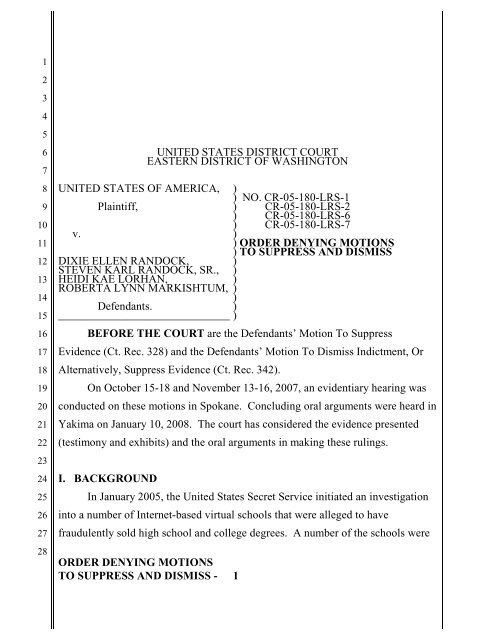
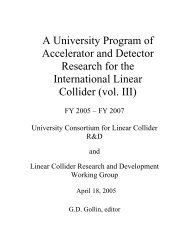
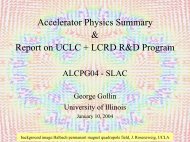
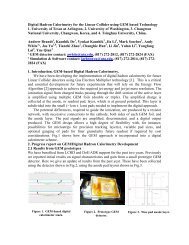
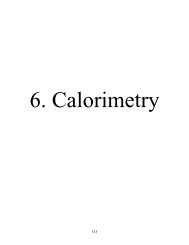

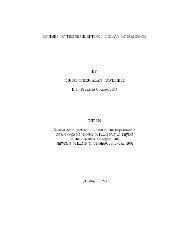
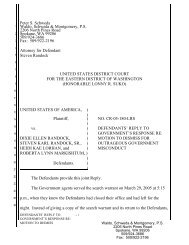
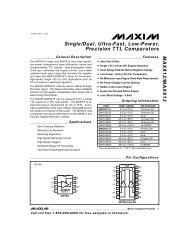
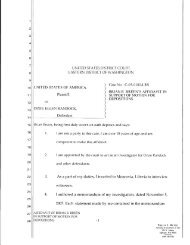
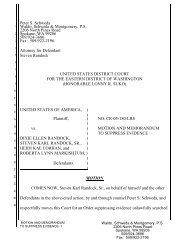
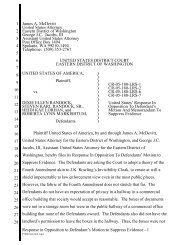
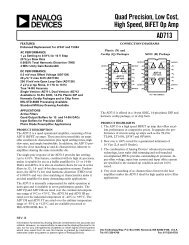
![Linear Collider [Accelerator] Overview](https://img.yumpu.com/33867705/1/190x143/linear-collider-accelerator-overview.jpg?quality=85)
